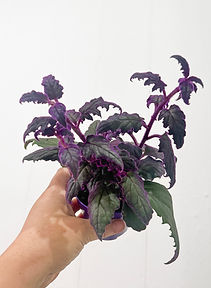

GYNURU
Also known as the Purple Passion Plant this absolute stunner has velvety green leaves covered in vibrant purple hairs.


WATER
Keep the soil consistently slightly moist, but not soggy. Water when the top few cm's of soil feels dry. Gynura don't like wet feet, so ensure your pot has drainage holes.
Do not mist as water on leaves to prevent rot or mould on the fuzzy surface.
LIGHT
Gynuru thrives in bright, indirect light. Too little light and you will have leggy growth, too much direct light and you will scorch the leaves.
FERTILISING
You can feed you Gynuru every 2 to 4 weeks during the spring and summer months to promote vibrant growth.
SOIL
Your Gynuru will grow best in a well draining soil mix. Visit our soil bar to add horticultural sand and perlite to a standard houseplant soil.
TEMPERATURE
Normal household temperatures will be fine as long as your Gynuru is away from cold drafts and not exposed to sudden temperature changes.
HUMIDITY
Your Gynuru will enjoy a humidity boost. You can achieve this by placing the plant in a naturally more humid room such as a kitchen or bathroom, grouping plants together, using a pebble tray or investing in a humidifier. We don’t recommend misting generally but this is especially important for Gynuru as the haird can trap water and rot the leaves.
TOXICITY
Gynuru are considered toxic to humans and animals.
General Watering Tips
Place your plant, still in its plastic nursery pot, inside the decorative pot you've chosen. This setup allows the plant to enjoy the drainage and airflow provided by the nursery pot's holes, which are beneficial for root health.
When it’s time to water, you have two options:
1. Top Watering: Take the plant, nursery pot and all, out of the decorative pot and water it over a sink. Allow the water to drain completely before placing it back in the decorative pot to prevent water build up.
2. Bottom Watering: Place the nursery pot in a shallow dish of water and let the plant absorb moisture from the bottom. This method encourages the roots to grow downward and reduces the risk of overwatering.
Both methods help keep your plant healthy by promoting good drainage and root aeration.
